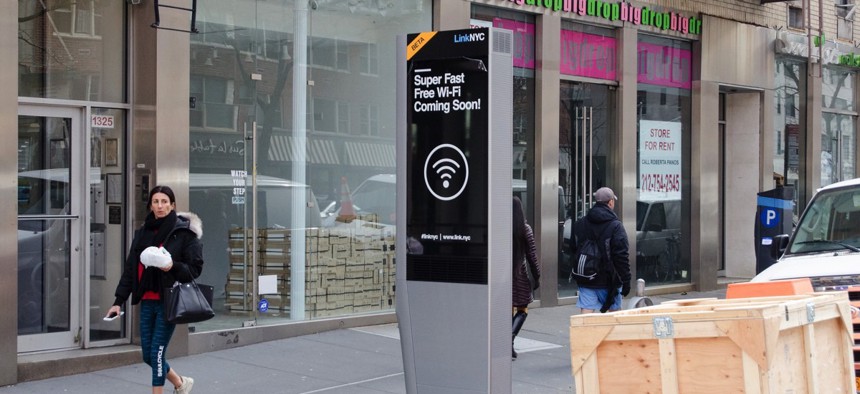LinkNYC’s Link Creator Looks to New ‘Smartscapes’

A LinkNYC Link structure in New York City, New York. Edward Blake / Flickr.com

Connecting state and local government leaders
Will the smart infrastructure equivalent of the iPhone speed the digitization of more cities?
WASHINGTON — New York City’s digital sidewalk kiosks may soon be coming to a city near you.
The foundation of LinkNYC’s super-fast, free public Wi-Fi network, the Links were built and deployed by Milford, Massachusetts-based smart communications company CIVIQ Smartscapes.
CIVIQ defines “smartscaping” as updating obsolete city infrastructure with intelligent infrastructure that provides a broad range of services beneficial to citizens and is paid for through advertising. And the nation's largest city is only the beginning.
“When we go into cities to solve a problem, we’re not just going to put a box on their street,” Brad Gleeson, CIVIQ’s chief commercial officer, said in an interview during Smart Cities Week at the Walter E. Washington Convention Center in the nation's capital. “We’ll customize public wayfinding for, say, Broadway shows and sensors for community engagement. In that way, smartscapes become very local.”
The company plans to announce a new version of their product at the end of this year, he said, and it will be tailoring capabilities based on the solutions new customer cities are looking for.
Tweaks can even be made to the Links’ appearance, though CIVIQ hopes to stick with something of an aesthetic standard. CIVIQ hired industrial designer Antenna Design, which has a permanent exhibit in New York’s Museum of Modern Art, to create the external look and feel for LinkNYC.
But the company wants its Links to become the “iPhones of the street”—meaning functionality and user experience should remain predictable from city to city. That said, the next system CIVIQ deploys for a customer could be more informational device than redesigned phone booth, as was the case in New York City.
CIVIQ is considering an ecosystem of potential partners, service providers that could deploy Internet of Things applications on top of the network like Cisco Systems, Intel, Siemens, and IBM.
“Cities don’t want death by 1,000 pilots,” said Erwin Rezelman, CIVIQ’s president. “Integrated management consolidates the platform, which lowers cost barriers.”
While software is easy to upgrade, CIVIQ developed Link hardware in components to futureproof them and make them upgradeable as well—with better sensors, Wi-Fi and screens over time.
With LinkNYC, CIVIQ was part of the CityBridge consortium, also including Intersection and Qualcomm, that won the request for proposals to replace New York City’s telephone booths with interactive structures that would close the city’s digital divide.
Already eight months into establishing the broadband network and about 500 Links have been installed throughout Manhattan, the Bronx and Brooklyn, Gleeson said. The contractual minimum number of Links needed for complete Wi-Fi coverage across all five boroughs is between 7,500 and 10,000, a number that will be settled on closer to completion of installation.
Around 575,000 subscribers have interacted with LinkNYC Links via their mobile devices, and the network has processed somewhere in the ballpark of 1.6 terabytes of data over the course 26 million sessions.
That’s not to say LinkNYC hasn’t faced early challenges.
“It’s been reported the city did have people monopolizing use of the devices to browse the internet for extended periods and trying hard to access inappropriate content,” Gleeson said.
At the city’s urging, open browsing on the Links’ tablets was disabled, but free public Wi-Fi remains.
While the Links’ filtering system managing access was the industry standard, CIVIQ hopes to eventually bring back a “walled garden,” where users can browse a subset of the locations they once could, Gleeson said.
“Some people will take a system to its extremes, and we want to be able to deliver all services on a more controlled system,” he added. “We’re still in pilot mode, and this is a learning exercise. In some cases, they’re the people we want to reach the most.”
Dave Nyczepir is a News Editor at Government Executive’s Route Fifty and is based in Washington D.C. (Photo by Flickr user Edward Blake via CC BY 2.0)

NEXT STORY: Bringing big data to bear on infectious disease





